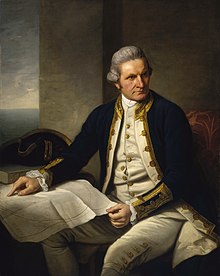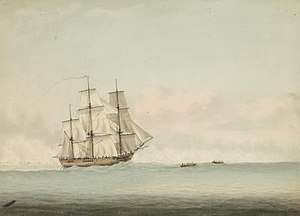1775 Portrait of James Cook

Captain James Cook of the Royal Navy was a British explorer, cartographer, and navigator. He commanded three voyages of exploration and circumnavigated the globe twice. It was on his first voyage that he commanded the research vessel
His Majesty's Bark Endeavour on a trip to Australia and New Zealand.
The Endeavor was originally launched in 1764 as the
Earl of Pembroake. The Royal Navy purchased her in 1768 for Cook's expedition and renamed her
His Majesty's Bark Endeavour. A Bark is a class of sailing vessel with two or more square rigged masts and a missen or aftermost mast rigged fore and aft.
Endeavour was 97'8" long, 29'2" wide at the beam, and had 3,221 yards of sail. The ships complement of 94 included 71 ships company, 12 marines and 11 civilians. She was armed with ten four pound cannons and twelve swivel guns. Her landing and other boats included a yawl, a pinnace, a longboat, and two skiffs.
1798 Painting of
HMS Endeavour by Samuel Atkins

Cook's voyage aboard the
Endeavour began in 1768 from Plymouth. She sailed south along the coast of Africa and crossed the Atlantic to South America at Rio de Janeiro where fresh provisions were brought on board. After a difficult passage around Cape Horn the scientists collected samples on the south west coast of South America. The next leg of the trip was to sail west-northwest to Tahiti. The
Endeavour and her crew spent the next three months in Tahiti and accomplished a scientific observation of the transit of Venus across the Sun. From Tahiti the
Endeavour sailed to New Zealand and spent the next six months mapping the coastline.
The voyage then continued to Australia, spending the next four months charting the coast. She became the first European ship to reach the east coast of Australia in April of 1770. As she sailed north to chart the Australian coast line she ran aground on the Great Barrier Reef. The ship was severely damaged. After much effort and emergency repairs she was floated off the reef and beached for further repairs. Cook then sailed her to Batavia (modern day Jakarta, Indonesia) where he was able to make more suitable repairs to continue his trip around the globe and back to England. Though the ship was sound after her repairs, the crew was not. All but 10 of the people on board the
Endeavour contracted malaria and dysentery while in Batavia. Seven of those people died before she embarked on the return voyage. Another 26 died on the way to Cape Town. Before leaving Cape Town the ill were allowed to recover and additional personnel were recruited. She returned to Dover on 12 July, 1771 after nearly three years at sea.
While Cook was not entirely pleased with the results of this expedition, it was acclaimed by the scientific community and the general public. He claimed the Pacific islands of Huahine, Bora Bora and Raiatea for Britain and charted the Pacific in much more detail than had been done previously. Cook was killed during a fight with native Hawaiians on 14 February 1779
After Cooks voyage the
Endeavour made several trips to and from the Falkland Islands over the next three years. Under the name
Lord Sandwich she was used as a troop carrier during the American war of Independence. She was finally scuttled in a blockade off the Rhode Island coast. Today there are two full sized replicas of the
Endeavour, one in Sydney, Australia's Darling Harbour and the second on the River Tees in Stockton-on-Tees, North East England.
Full sized replica of the
HMS Endeavour in Sidney Harbour
HMS Endeavour Quality Tall Ship Model

For more information on Captain Cook click
here.
Ship Models Online offers a scale model of the
HMS Endeavour as well as an open hull scale model of the
HMS Endeavour. with a considerable amount of interesting detail.
HMS Endeavour Open Hull Scale Quality Tall Ship Model















